Three straightforward ideas—time, distance, and shielding—can be used to summarize the fundamental principles of radiation safety. Insulating and X-ray chamber design need careful consideration and execution through the operator or Radiation Protection Officer, even though both restricting the amount of duration served and expanding the closeness to an ingesting radiation sources are things that fall within the ability of the person.
What exactly is radiation protection?
Simply said, radiation protection is a boundary erected between a radioactivity generator and the object or human that has to be shielded. Radiation protection is used to restrict, regulate, or change the radiation emission level at a predetermined spot.
Absorption, or the steady reduction in radiation intensity across a particular material, is the foundation of protection. The amount of X-ray irradiation that gets through some materials is reduced and absorbed, which lowers the visibility on the opposite part of the boundary.
Materials for securing.
Incapacitating radiation protection can be provided by a variety of materials. Boundaries that stop various types of radiation and particles include masonry, liquid, special polymer shields, airflow stops, and leads. This lowers the overall dosage that an individual absorbs.
The most often utilized shielding substances in medical settings are leads, lead-free protection, and lead mixtures.
Radioactivity Scattering and Protecting.
Medical staff members including operatives, radiologists, and technicians may be needed to stay in the area with the customer for specific diagnostic X-ray treatments. They are regularly exposed because of this closeness to disperse radiation, which is radioactivity that throughout a surgery reflects off a person’s body.
Many medical professionals are obliged to wear lateral or complete wrap-around type lead jackets, thyroid shielding, and lead goggles in order to reduce this contamination. These protective clothing may absorb 93% of rays at energies that are generally dispersed.
Protecting design and commodities.
Radiation insulation can be used or created in a variety of ways to safeguard healthcare personnel.
Room Protection.
In almost any X-ray as well as radioactive material usage room, shielding can be necessary for the walls, doors, roof, floors, or any other surface. Workers, customers, or members of the public who might be in nearby rooms or spaces are shielded.
Special shielding components are put in place where they are needed throughout a room’s development. These materials may consist of pipe insulation, lead-lined plasterboard or hardwood, lead plates for floors as well as roofs, lead-lined frames and gates, and more.
State-by-state differences exist in X-ray chamber shielding regulations. Before establishing a fresh room, this is crucial to get advice from a certified professional who is aware with these laws and engage with an engineer skilled in developing X-ray facilities.
Leaded windows and drapes.
In rare circumstances, a facility may not be able to incorporate protection into the actual design of a construction.
Doctors and technicians utilize leaded glass boundaries to securely see patients while doing imaging procedures. Due to its substantial lead concentration, this kind of glassware is perfect for radioactive material devices throughout between 80-300 kV scope.
Workers exposed to radioactivity are also shielded by lead drapes, especially in big veterinary clinics or operating theatres. Leaded latex or vinyl strips used as these drapes are excellent for shielding from low-level as well as secondary radioactivity. In general, they provide shielding between 0.5mm through 2.00mm lead comparability and provide for space-saving walls that may be opened or shut as needed.
Mobile protecting barriers.
Under certain circumstances, additional safeguards are required to protect medical professionals throughout diagnostic imaging procedures such as radiography, nuclear science, cath laboratory, or radiation oncology. These obstructions are mobile lead-lined dividers that frequently have a covered window to permit patient viewing.
Mobile radiation shields are available in several forms, dimensions, and lead equivalents. They are perfect for preserving mobility and mobility in an operating theatre while effectively reducing the dispersed radiation dosage to nearby personnel.
Final thoughts
It might take a lot of effort to comprehend the specific shielding regulations for your jurisdiction or institution. If carried out improperly, there may be major repercussions for the radiation technicians’, patients’, and constructing staff’s welfare and security in addition to significant fines for noncompliance with regulations. It is crucial to employ a radiation protection specialist for this reason.




















